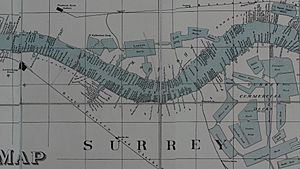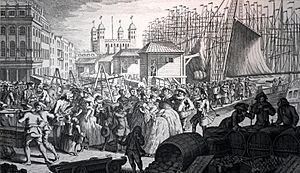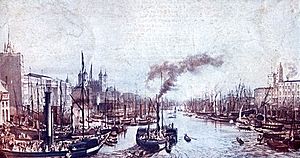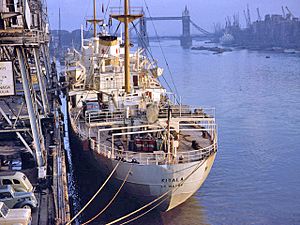Pool of London facts for kids
The Pool of London is a famous part of the River Thames in London. It stretches from London Bridge down to an area called Limehouse.
This section of the river was once super important for trade. It was deep enough for large ships with tall masts to sail in. These ships brought goods from other parts of Britain and from overseas. The wharves (docks) here were the original part of the Port of London. The Pool of London is split into two main sections. The Upper Pool goes from London Bridge to Cherry Garden Pier in Bermondsey. The Lower Pool runs from Cherry Garden Pier to Limekiln Creek.
History of the Pool of London
The Pool of London has a long and interesting history. Originally, it was the part of the River Thames near Billingsgate. This was where all imported goods had to be brought. Customs officers would check and tax the goods here. This area was known as the "Legal Quays."
For many centuries, the Pool of London was vital for the city. As early as the 600s, a writer named Bede said it was why London existed. It was busiest in the 1700s and 1800s. The riverbanks were lined with wharves for miles. Hundreds of ships were always docked or waiting in the river.
Trade grew incredibly fast during this time. Many ships were colliers, bringing coal to London. The city's population was growing, so more coal was needed. Between 1750 and 1796, coastal trade nearly doubled. Overseas trade also saw a huge increase. In 1751, the Pool handled 1,682 ships. By 1794, this number had jumped to 3,663 ships.
The river became extremely crowded. People even said you could walk across the Thames by stepping from ship to ship! This huge amount of traffic led to a problem: there wasn't enough space. This lack of space led to the creation of the London Docklands. New, enclosed docks were built away from the main river. These new docks offered better security and facilities.
Even after the new docks were built, the Pool of London remained important. Ships still needed to reach it easily. This made it tricky to build new bridges across the river. The Thames Tunnel was built between 1825 and 1843. It connected Rotherhithe to Wapping under the river. Tower Bridge opened in 1894. It was a special bridge that could open up to let tall ships pass.
In 1909, the Port of London Authority took charge of the Pool. The docks continued to be busy until the 1950s. They even recovered after being badly damaged during World War II.
However, in the 1960s, things changed quickly. New shipping containers became popular. These needed huge, deep-water ports, which London didn't have. So, commercial traffic on the Thames stopped almost completely. All the wharves in the Pool of London closed down. Many were even pulled down. In the 1980s and 1990s, the area was rebuilt. New homes and businesses were created.
Modern Changes and Renewal
In 1996, a group called the Pool of London Partnership was formed. Their goal was to help improve the areas on both sides of the river. They also worked on nearby areas like St Katharine Docks and Shad Thames.
After ten years of successful work and a lot of investment, the Partnership finished its job in 2007. Its work was then continued by other groups.
Today, the "core area" of the Pool of London includes many famous places. These include Borough Market, London Bridge, Guy's Hospital, London Bridge station, Hay's Galleria, HMS Belfast, City Hall, Shad Thames, Tower Bridge, St Katharine Docks, the Tower of London, Tower Hill Underground station, and the Monument to the Great Fire of London.
See also
 In Spanish: Pool of London para niños
In Spanish: Pool of London para niños






